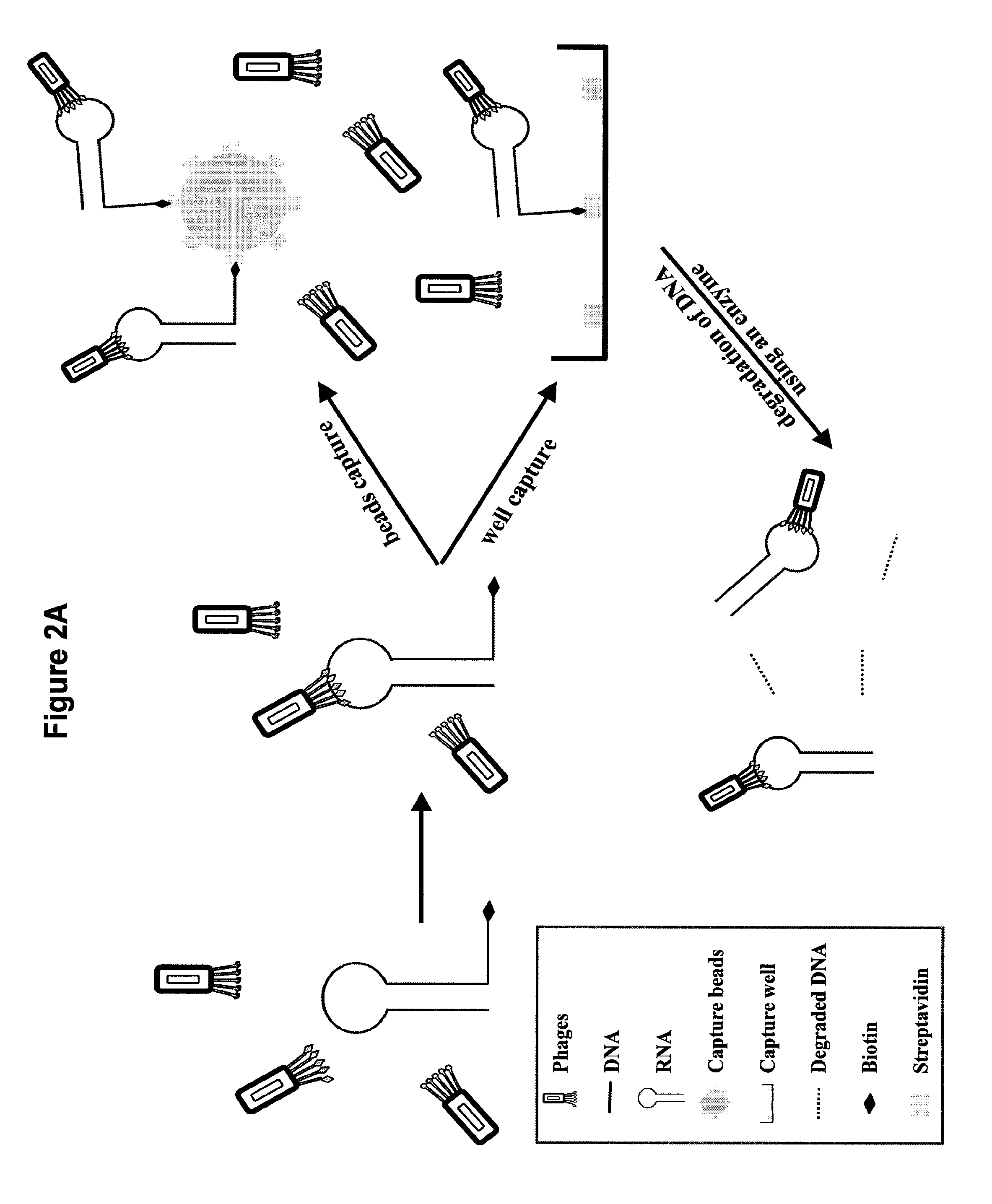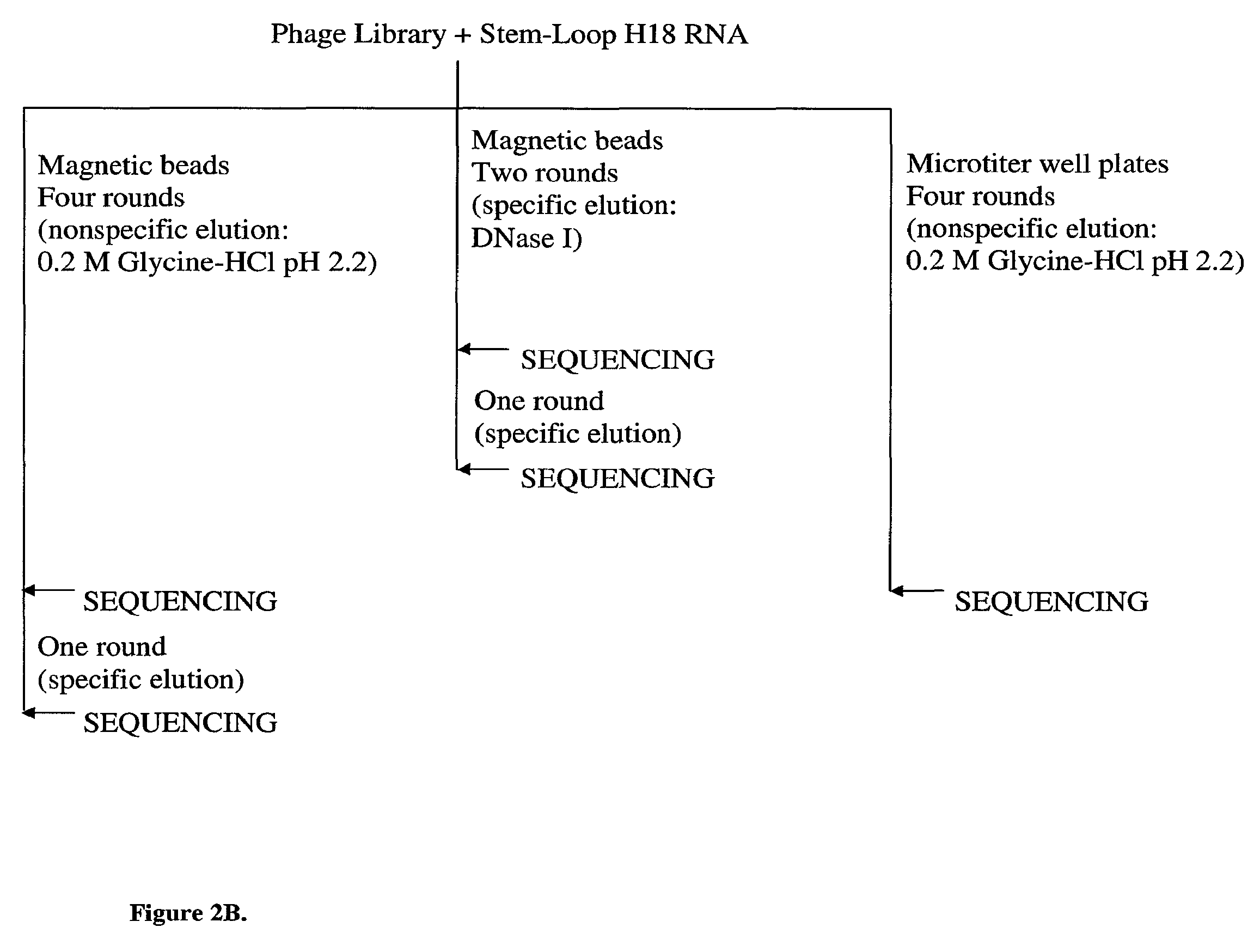Identification and use of peptide inhibitors of protein synthesis
a technology of protein synthesis and peptide inhibitors, which is applied in the field of identification and use of novel peptide inhibitors of protein synthesis, can solve the problems of drug resistance becoming increasingly difficult in hospitals, affecting the ability to survive, and bacterial resistance to currently known classes of antibiotics is a major worldwide health problem, so as to prevent bacterial infection, inhibit growth, and prevent bacterial growth
- Summary
- Abstract
- Description
- Claims
- Application Information
AI Technical Summary
Benefits of technology
Problems solved by technology
Method used
Image
Examples
example 1
Materials and Methods
(i) Materials
[0115]Target RNA. The RNA used as a target to select for peptide binding was a 59-nt RNA-DNA construct representing the stem-loop H18 of Bacillus anthracis small ribosomal subunit, H18 RNA (5′-GGGGCCACGGCUAACUACGUGCCAGCAGCCGCGGUAA UACGUAGGUGGCdAdAdAdAdAdAdAdAdAdABiotin-3′) (Seq. ID. NO: 1). Three additional guanosines were added at the 5′end, and a poly-dA tail of 10 nucleotides followed by a biotin molecule was added at the 3′end. The RNA-DNA hybrid was obtained from Dharmacon RNA Technologies and purified by gel electrophoresis on denaturing (8 M urea) 8% polyacrylamide gels. H18 RNA was renatured in 80 mM HEPES-KOH pH 7.4, the RNA was incubated at 90° C. for 1 min in a water bath and allowed to cool down to 20° C. for 2 h.
(ii) Screening of Phage-Displayed Peptide Library.
[0116]The Ph.D.-7 phage library from New England Biolabs was used, which contains a library of 1.28×109 random heptapetides fused to coat protein pIII of M13 Phage. Two parallel ...
example 2
[0125]The following example shows one way the selection method of the present invention can be used. In this example, a novel target site in a ribosomal unit was used to screen for peptides with affinity to the novel target site. In this example, the extended target molecule is an RNA / DNA hybrid construct wherein the DNA is tagged with biotin. Various other target molecules and affinity tags are contemplated in this invention as discussed above.
[0126]The affinity selection methodology was designed and developed using the two capture formats of magnetic beads and microtiter plates, and two elution systems including nonspecific elution, and specific elution by enzymatic digestion of the specifically designed poly-dA tail of H18 RNA with DNase I. H18 RNA at a concentration of 100 nM was allowed to interact with the phage library in solution in the presence of tRNA (2 μg / μL). The RNA-binding phage were captured using either capture format, and biotin was added to...
example 3
The Indentified Peptides can Inhibit Protein Synthesis
[0132]The synthesized peptides were tested for their inhibitory activity in protein synthesis using cell-free translation assays from E. coli. The system uses a circular DNA template in a coupled in vitro transcription / translation reaction for the production of the protein luciferase. The system was supplemented with the radiolabeled amino acid [35S]methionine to measure total production of luciferase in the assay. Inhibition of luciferase synthesis by the selected peptides was tested at a peptide concentration of 100 μM. As was expected from the important functional role of H18-stem loop in the ribosomal subunit, inhibition of protein synthesis was observed. The strongest inhibitors of protein synthesis were peptides BLS15, BLS17, and BLS18 (FIG. 3) with a percent inhibition of 70-80%. Peptides BLS6, BLS14, and BLS20 inhibited protein synthesis by 30-40%. A 20% stimulation of protein synthesis was also observed by peptides BLS25...
PUM
 Login to View More
Login to View More Abstract
Description
Claims
Application Information
 Login to View More
Login to View More - R&D
- Intellectual Property
- Life Sciences
- Materials
- Tech Scout
- Unparalleled Data Quality
- Higher Quality Content
- 60% Fewer Hallucinations
Browse by: Latest US Patents, China's latest patents, Technical Efficacy Thesaurus, Application Domain, Technology Topic, Popular Technical Reports.
© 2025 PatSnap. All rights reserved.Legal|Privacy policy|Modern Slavery Act Transparency Statement|Sitemap|About US| Contact US: help@patsnap.com



